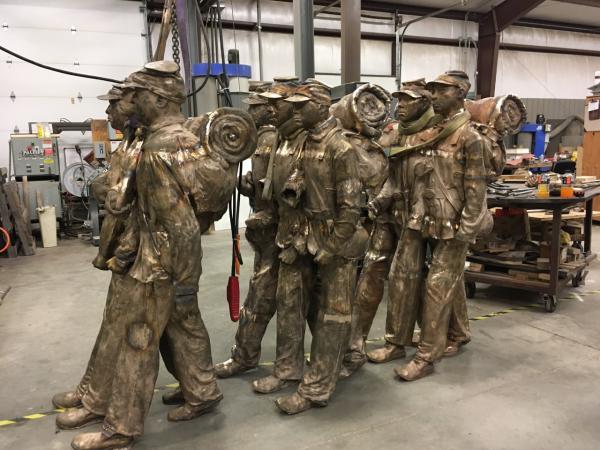I’ve lived in the South most of my life, yet I was well into my 30s before I learned the story of the United States Colored Troops (USCT). I remember hearing a Civil War reenactor say, "The North was fighting to preserve the Union. The South was fighting for state’s rights. The USCT were fighting for their freedom." These words hit me like a lightning bolt and following the thread of the USCT narrative has led me to think deeply about the landscape of the place I call home, about who we are as a community, and who we want to be.
A New Public Sculpture
In November 2021 the Cameron Art Museum (CAM) in Wilmington, NC, unveiled its new public sculpture, Boundless, by North Carolina artist Stephen Hayes. The sculpture is life-size, bronze, and situated on the sandy soil where the USCT once fought. Boundless depicts 11 men marching, three rows of three soldiers, a drummer boy, and a color bearer. A real flag flaps in the wind. An audio component allows visitors to hear the rhythm of soldiers marching, chanting, and singing.

As an employee of CAM, I have had the honor of working on this public art project since 2018. CAM is an art museum in a unique position in that we are also charged with the stewardship of a historic Civil War site, one where more than 2,000 USCT fought for their freedom. The CAM is surely the only art museum in the nation with this distinction.
Enter Artist Stephen Hayes
From the beginning, the museum wanted to honor the USCT with a work of contemporary art worthy of their story. Enter artist Stephen Hayes, who teaches at Duke University and is the recipient of the 2020 1858 Prize for Contemporary Southern Art. Known for his emotive figurative work, Hayes’ work has been featured at the National Cathedral in DC and at the Gibbs Art Museum in Charleston, SC, among others. Hayes is a patient and thoughtful creator, a talented artist whose works are both thought-provoking and haunting.
The USCT
For the sculpture, Hayes cast the features of USCT descendants, reenactors, and African American military veterans, including a young student from Cape Fear Community College and a young local man who is a descendant of four USCT soldiers.
Hayes wanted the life-size sculpture to function on multiple levels; it is not merely a monument to the USCT. The sculpture pays tribute to the USCT and their legacy, while also recognizing the continuing fight for civil rights by these 11 modern-day men.
The sculpture is situated on the last remaining vestige of Federal Point Road, the actual road these men marched upon from Fort Fisher to Wilmington. They stand on the road, active and proud. On the back of the sculpture are inscribed the names 1820 men of the 1st, 5th, and 37th USCT who fought in the Battle of Forks Road. These names were researched by a group of community volunteers, led by a local public historian. Thanks to their research, we now know that these men were as young as 12 and as old as 45, that they came to military service as carpenters, cooks, barbers, and farmers. Some were escaped slaves; some were freedmen. All were fighting for the abolishment of slavery. We know that they were from as far away as Ohio and that some of them stayed and settled in southeastern NC after the Civil War.
How to Visit
Beginning November 13, 2021, visitors to the Cameron Art Museum can view Boundless and reflect upon the story and lives of the USCT soldiers who fought for freedom. The outdoor sculpture is located on the museum’s grounds and can be accessed for free any time the museum is open. Stephen Hayes’s sculpture Boundless proclaims that the USCT story is important, is valued, and is not forgotten. With the sculpture as its focal point, the CAM will open the state’s first USCT park as a space for learning and reflection, coming in fall 2022.
CAM Related Events:
- Voices of Future’s Past Exhibition: Stephen Hayes (Nov. 13, 2021 - March 20, 2022) - Born in Durham, N.C., Stephen L. Hayes is the 2020 recipient of the 1858 Contemporary Southern Art Prize. Hayes is a creator who works with a variety of mediums – sculpture, casting, knitting, woodcuts, video, and audio – to explore issues of race and economics in the United States.
Hayes writes, “Like the works of contemporary American artists such as Willie Cole or Radcliffe Bailey, my work centers around finding beauty and understanding between myself, as a black male artist, and the nature of the object. My work fuses the past and the present, generally based on socio-cultural and economic themes, highlighting American history as it relates to race, identity, and stereotypes in the areas of capitalism, the commodification of beings, and the subsequent effects of cultural representation.”



